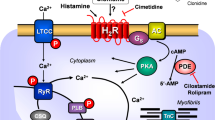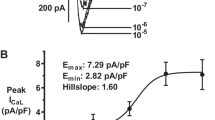Abstract
We have reported that chronic treatment of patients with β1-adrenoceptor blockers sensitises isolated atrial preparations to adrenaline, noradrenaline and 5-HT. We have now examined the effect of chronic treatment with β-adrenoceptor blockers on responses to histamine of human right atrial appendages. We compared the effects of histamine on contractile force, cyclic AMP and cyclic GMP levels as well as cyclic AMP-dependent protein kinase (PKA) activity and explored the arrhythmogenic effects of histamine in preparations obtained from patients chronically treated or not treated with β-adrenoceptor blockers.
Histamine increased contractile force in paced preparations; the effects were blocked by the H2 receptor antagonist famotidine (0.1–30 μmol/1). The maximum inotropic response to histamine was doubled and the inotropic potency of histamine 0.4 log units greater in atria from β-adrenoceptor blocker-treated compared to non β-adrenoceptor blocker-treated patients. Histamine elicited frequency-dependent arrhythmias that were blocked by famotidine (30 μmol/1) but not by mepyramine (1 μmol/1). The incidence of arrhythmias was higher in atria from β-adrenoceptor blocker-treated compared to untreated patients. Histamine increased both cyclic AMP and cyclic GMP levels, as well as PKA activity, significantly more in atria from β-adrenoceptor blocker-treated compared to those from untreated patients. Mepyramine 1 μmol/l prevented the histamine-evoked increase in cyclic GMP levels, reduced the inotropic hyperresponsiveness and abolished the hyperresponsiveness in cyclic AMP levels and PKA activity observed in patients chronically treated with β blockers. Sodium nitroprusside 10 μmol/l caused smaller increases of cyclic GMP levels than histamine and restored the contracile force depressed by mepyramine to its original level in atria from β-adrenoceptor blocker-treated patients.
The evidence is consistent with sensitisation of both the histamine H1 and histamine H2 receptor systems by chronic β1-adrenoceptor blockade. H1 receptor-mediated increases in cyclic GMP, enhanced through an as yet unknown mechanism by chronic β1-adrenoceptor blockade, may inhibit phosphodiesterase 3 activity, thereby causing enhanced histamine-evoked increases in cyclic AMP levels and PKA activity, and accounting partially for the increased inotropic responses to histamine through H2 receptors.
Similar content being viewed by others
References
Arunlakshana O, Schild HO (1959) Some quantitative uses of drug antagonism. Br J Pharmacol 14:48–58
Beavo JA (1988) Multiple isoenzymes of cyclic nucleoside phosphodiesterases. Adv Second Messenger Res 22:1–38
Beavo JA, Reifsnyder DH (1990) Primary sequence of cyclic nucleoside phosphodiesterase isoenzymes and the design of selective inhibitors. Trends Pharmacol Sci 11:150–155
Beavo JA, Conti M, Heaslip RJ (1994) Multiple cyclic nucleotide phosphodiesterases. Mol Pharmacol 46:399–405
Black JW, Leff P, Shankley NP (1985) Further analysis of anomalous pKB values for histamine H2-receptor antagonists on the mouse isolated stomach assay. Br J Pharmacol 86:581–587
Bradford M (1976) A rapid and sensitive method for the quantitation of microgram quantities of protein utilizing the principle of protein-dye binding. Anal Biochem 72:248–254
Brady AJB, Warren JB, Poole-Wilson A, Williams TJ, Harding SE (1993) Nitric oxide attenuates cardiac myocyte contraction. Am J Physiol 265 (Heart Circ Physiol 34):H176-H182
Bristow MR, Cubicciotti R, Stinson EB, Johnson C (1982) Histamine-mediated adenylate cyclase stimulation in human myocardium. Mol Pharmacol 21:671–679
Dooley DJ, Bittiger H, Reyman NC (1986) A useful tool for quantitating β1- and β2-adrenoceptors. Eur J Pharmacol 130:137–139
Eckel L, Gristwood RW, Nawrath H, Owen DAA, Satter P (1982) Inotropic and electrophysiological effects of histamine on human ventricular heart muscle. J Physiol 330:111–123
Genovese A, Gross S, Sakuma I, Levi R (1988) Adenosine promotes histamine H1-mediated negative chronotropic and inotropic effects on human atrial myocardium. J Pharmacol Exp Ther 247:844–849
Gille E, Lemoine H, Ehle B, Kaumann AJ (1985) The affinity of (−)-propranolol for β1- and β2-adrenoceptors of human heart. Differential antagonism of the positive inotropic effects and adenylate cyclase stimulation by (−)-noradrenaline and (−)-adrenaline. Naunyn-Schmiedeberg's Arch Pharmacol 331:60–70
Ginsburg R, Bristow ME, Stinson EB, Harrison DC (1980) Histamine receptors in the human heart. Life Sci 26:2245–2249
Gristwood RW, Lincoln JCR, Owen DAA, Smith IR (1981) Histamine release from human right atrium. Br J Pharmacol 74:7–9
Guo Z-G, Levi R, Graver M, Robertson D, Gay WA (1984) Inotropic effects of histamine in human myocardium: differentiation between positive and negative components. J Cardiovasc Pharmacol 6:1210–1215
Hall JA, Kaumann AJ, Brown MJ (1990) Selective β1-adrenoceptor blockade enhances positive inotropic responses to endogenous catecholamines mediated through β2-adrenoceptors in human atrial myocardium. Circ Res 66:1610–1623
Hattori Y, Sakuma I, Kanno M (1988) Differential effects of histamine mediated by H1- and H2-receptors on contractility, spontaneous rate and cyclic nucleotides in the rabbit heart. Eur J Pharmacol 153:221–229
Kaumann AJ (1986) The β1-adrenoceptor antagonist CGP 20712A unmasks β2-adrenoceptors activated by (−)-adrenaline in rat sinoatrial node. Naunyn-Schmiedeberg's Arch Pharmacol 332:406–409
Kaumann AJ (1991a) Regulation of cardiac β-adrenoceptors by antagonists. In: Szabadi E, Bradshaw CM (eds) Adrenoceptors: structure, mechanisms, function. Advances in pharmacological sciences. Birkhäuser, Basel pp 221–230
Kaumann AJ (1991b) Some aspects of heart β-adrenoceptor function. Cardiovasc Drugs Ther 5:549–560
Kaumann AJ (1994) Do human atrial 5-HT4 receptors mediate arrhythmias? Trends Pharmacol Sci 15:451–455
Kaumann AJ, Lemoine H (1987) β-adrenoceptor-mediated positive inotropic effect of adrenaline in human ventricular myocardium: Quantitative discrepancies with binding and adenylate cyclase stimulation. Naunyn-Schmiedeberg's Arch Pharmacol 335: 403–411
Kaumann AJ, Sanders L (1993) Both β1- and β2-adrenoceptors mediate catecholamine-evoked arrhythmias in isolated human atrium. Naunyn-Schmiedeberg's Arch Pharmacol 348:536–540
Kaumann AJ, Sanders L (1994) 5-Hydroxytryptamine causes rate-dependent arrhythmias through 5-HT4 receptors in human atrium: facilitation by chronic β-adrenoceptor blockade. Naunyn-Schmiedeberg's Arch Pharmacol 349:331–337
Kaumann AJ, Hall JA, Murray KJ, Wells FC, Brown MJ (1989) A comparison of the effects of adrenaline and noradrenaline on human heart: the role of β1- and β2-adrenoceptors in the stimulation of adenylate cyclase and contractile force. Eur Heart J 10 [Suppl B]:29–37
Kaumann AJ, Sanders L, Brown AM, Murray KJ, Brown MJ (1991) A 5-HT4-like receptor in human right atrium. Naunyn-Schmiedeberg's Arch Pharmacol 344:150–159
Kirstein M, Rivet-Bastide M, Hatem S, Benardeau A, Mercadier J-J, Fischmeister R (1995) Nitric oxide regulates the calcium current in isolated human atrial myocytes. J Clin Invest 95:794–802
Levi R (1988) Cardiac anaphylaxis: models, mediators, mechanisms and clinical considerations. In: Marons G, Lichtenstein L, Condorelli M, Fauci A (eds) Human inflammatory disease. Decker, Toronto Canada, pp 93–105
Levi R, Malm JR, Bowman FO, Rosen MR (1981) The arrhythmogenic actions of histamine on human atrial fibers. Circ Res 49:545–550
Michel MC, Pingsmann A, Beckeringh JJ, Zerkowski H-R, Doaetsch N, Brodde O-E (1988) Selective regulation of β1- and β2-adrenoceptors in the human heart by chronic β-adrenoceptor antagonist treatment. Br J Pharmacol 94:685–692
Motomura S, Deighton NM, Zerkowski H-R, Doetsch N, Michel MC, Brodde O-E (1990) Chronic β1-adrenoceptor antagonist treatment sensitises β2-adrenoceptors, but desensitises M2 muscarinic receptors in human right atrium. Br J Pharmacol 101:363–369
Ono K, Trautwein W (1991) Potentiation by cyclic GMP of β-adrenergic effect on Ca2+ current in guinea-pig ventricular cells. J Physiol 443:387–404
Ruat M, Bouthenet ML, Schwartz J-C, Ganellin CR (1990) Histamine H1-receptor in heart: unique electrophoretic mobility and autoradiographic localization. J Neurochem 55:379–385
Sakuma I, Gross S, Levi R (1988) Positive inotropic effect of histamine on guinea pig left atrium: H1-receptor-induced stimulation of phosphoinositide turnover. J Pharmacol Exp Ther 247:466–472
Sanders L, Lynham J, Bond B, delMonte F, Harding SE, Kaumann AJ (1995) Sensitization of human atrial 5-HT4 receptors by chronic β blocker treatment. Circulation 92:2526–2539
Schulz R, Smith JA, Lewis MJ, Moncada S (1991) Nitric oxide synthase in cultured endocardial cells of the pig. Br J Pharmacol 104:21–24
Schulz R, Nava E, Moncada S (1992) Induction and potential biological relevance of a Ca2+-independent nitric oxide synthase in the myocardium. Br J Pharmacol 105:575–580
Siegel S (1956) Nonparametric statistics for the behavioral sciences. McGraw Hill, New York, pp 95–110
Smith JA, Shah AM, Lewis MJ (1991) Factors released from endocardium of the ferret and pig modulate myocardial contraction. J Physiol 439:1–14
Sugioka M, Ito M, Masuoka H, Ichikawa K, Konishi T, Tanaka T, Nakano T (1994) Identification and characterization of isoenzymes of cyclic nucleotide phosphodiesterase in human kidney and heart, and the effects of new cardiotonic agents on these isoenzymes. Naunyn-Schmiedeberg's Arch Pharmacol 350: 284–293
von der Leyen H, Mende U, Meyer W, Neumann J, Nose M, Schmitz W, Scholz H, Starbatty J, Stein B, Wenzlaff H, Daring V, Kalmar P, Haverich A (1991) Mechanism underlying the reduced positive inotropic effects of the phosphodiesterase III inhibitors pimobendan, adibendan and saterinone in failing as compared to nonfailing human cardiac muscle preparations. Naunyn-Schmiedeberg's Arch Pharmacol 344:90–100
Wolff AA, Levi R (1986) Histamine and cardiac arrhythmias. Circ Res 58:1–15
Zerkowski H-R, Broede A, Kunde K, Hillemann S, Schäfer E, Vogelsang M, Michel MC, Brodde O-E (1993) Comparison of the positive inotropic effects of serotonin, histamine, angiotensin II, endothelin and isoprenaline in the isolated human right atrium. Naunyn-Schmiedeberg's Arch Pharmacol 347:347–352
Author information
Authors and Affiliations
Rights and permissions
About this article
Cite this article
Sanders, L., Lynham, J.A. & Kaumann, A.J. Chronic β1-adrenoceptor blockade sensitises the H1 and H2 receptor systems in human atrium: role of cyclic nucleotides. Naunyn-Schmiedeberg's Arch Pharmacol 353, 661–670 (1996). https://doi.org/10.1007/BF00167185
Received:
Accepted:
Issue Date:
DOI: https://doi.org/10.1007/BF00167185




